C.P. Lesley's Blog, page 7
January 27, 2023
The Pull of the Past
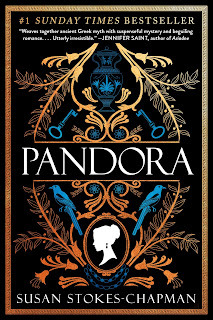 It’s said that there are no new plots for novels, only a recircling and revisiting of a few foundational stories, many of which date from antiquity. Boy Meets Girl, Hero’s Journey, Separation from Parents, Who Killed X and Why?—most fiction, especially genre fiction, can be shoehorned into categories like these. This is not an accident: stories exist to meet the needs and expectations of readers. Each of us is unique, to be sure, but we all go through a similar process of maturation, whatever distinctive forms our own families, cultures, and selves take as we traverse the path.
It’s said that there are no new plots for novels, only a recircling and revisiting of a few foundational stories, many of which date from antiquity. Boy Meets Girl, Hero’s Journey, Separation from Parents, Who Killed X and Why?—most fiction, especially genre fiction, can be shoehorned into categories like these. This is not an accident: stories exist to meet the needs and expectations of readers. Each of us is unique, to be sure, but we all go through a similar process of maturation, whatever distinctive forms our own families, cultures, and selves take as we traverse the path.As a result, the creativity and freshness that a given author applies to the fundamental questions expressed in these plots inherited from antiquity (or the Renaissance) are what sets a particular novel above the rest. As Susan Stokes-Chapman discusses in her recent New Books Network interview, she began with a historical event but ended up transposing the ancient Greek myth of Pandora’s Box to eighteenth-century London. There the fight for possession of a massive urn recovered from a Mediterranean shipwreck releases into the world the many ills that beset humanity: greed, envy, anger, dishonesty, and more—leaving its shattered survivors with only hope, as in the original myth.
Bits and pieces of the genre plots I list above also appear, but the whole is so deftly handled that we barely notice them because of the originality of the approach. So give the interview a listen, then read the book. It’s not an accident that the New York Times Book Review picked Pandora for its short list on historical fiction the very week of its release in the US.

As usual, the rest of this post comes from New Books in Historical Fiction.
It is the very end of the eighteenth century, and Pandora Blake—known as Dora—lives at the edge of London society. Despite the opposition of her obnoxious uncle Hezekiah and his live-in housekeeper/mistress Lottie, neither of whom has much interest in their orphaned charge, Dora has a dream. She wants to sketch jewelry designs that will appeal to the beauties of the haut ton, in the process earning Dora a livelihood sufficient to free her from her family’s antique shop, now in decline due to Hezekiah’s mismanagement. To that end, Dora spends hours in her attic bedchamber drawing with only her beloved magpie, Hermes, for company.
Even before we meet Dora in this enchanting yet troubling tale, we have encountered an unnamed diver bent on retrieving the cargo from a scuttered ship somewhere in the Mediterranean. It soon becomes clear that the mysterious cargo includes a massive Greek vase (more properly, a pithos, used for storing wine or grain), which Hezekiah acquires, together with a shipment of Greek pottery. Dora at first believes this is an attempt to save the store, but her uncle’s behavior raises questions—not least whether he obtained the pithos legally. To find out what Hezekiah has in mind, Dora enlists the help of a bookbinder, Edward Lawrence, setting them off on a journey that will lead deep into Dora’s past.
This is a novel of many layers, as intricately plotted as Dora’s jewelry designs, which seem to have inspired the book’s gorgeous cover. The characters and setting are Dickensian, yet the themes are modern and the reconsideration of the mythical story of Pandora’s Box rings true. Definitely a book worth reading.
Image: Pithos from Crete, ca. 675 BCE, public domain via Wikimedia Commons.
January 20, 2023
The Bachelor, Medieval Russian Style
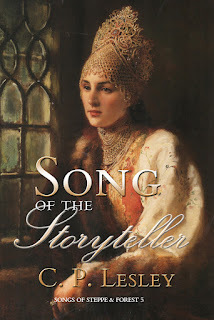 As promised, this past Tuesday Five Directions Press formally announced the release of my latest Songs of Steppe & Forest novel,
Song of the Storyteller
. As you might guess from the title of this post, I had a lot of fun writing this particular novel—and for several reasons.
As promised, this past Tuesday Five Directions Press formally announced the release of my latest Songs of Steppe & Forest novel,
Song of the Storyteller
. As you might guess from the title of this post, I had a lot of fun writing this particular novel—and for several reasons.First, Lyuba is the kind of heroine I find easy to connect to: strong-minded yet thoughtful, self-aware, and in love with words. Although I accept that every character, even the villains, represents one or more elements of myself, Lyuba—like her predecessor Nasan—is not so much me as the person I wish I could have been at sixteen. She has a poise I lacked (I was neurotically silent and shy), yet she loves stories, just as I have since before I even learned how to read. And although she’s beautiful—another trait I wouldn’t lay claim to—she has little awareness of and no interest in that fact; she cares far more about people’s minds and hearts than their looks—even her love interest Timur’s, although she’s certainly not immune to his charms.
Best of all, from the perspective of storytelling, Lyuba is a writer, so she naturally thinks in terms of describing the scenes she experiences, the settings in which they take place, and the characters she meets—and she meets some real doozies in the course of this book. She’ll exaggerate for effect and dramatic impact, but she’s also alert to hidden vulnerabilities and subtexts. The more I submerged myself in her world and her way of seeing, the more readily the story flowed. Even her passing remarks—grumbling when people interrupt her while she’s crafting a sentence, for example—fit both who she is and the unique experience of producing fiction.
Other writers will understand what I mean by that. People who, in Lyuba’s words, “don’t live with stories buzzing inside their heads” may find it strange. Aren’t all characters the author’s creation, like paper dolls dressed up and moved around a cardboard stage? Why would one heroine be easier to write than another?
But in fact, novel writing doesn’t work like that at all. Characters emerge from the subconscious, and the writing flows naturally from letting them chart their own course. My only experiences with the dreaded writer’s block have been when I tried to force a character into behavior that met the needs of the plot but not the personality of the character. Like real people, though, not all characters move comfortably in the larger world. The shy and ungainly, the poorly educated, the girls trained to silent submission (so common throughout much of history)—discovering what makes such heroines unique and memorable can take months, if not years. So when I come across a self-aware, active, fiery heroine like Lyuba, with her vast vocabulary and her talent for nailing in a few words what distinguishes each person she encounters, that’s a gift.
The second factor that eased the writing of this novel was the historical backdrop. From the moment I realized that Lyuba would be just a month or two younger than Ivan the Terrible when the tsar reached the age of coronation and marriage, I knew I must find a way to set her story during his first bride show. Long before I figured out how she would navigate this historical incident that to a modern mind almost defies belief, I wanted to examine the bride show from her perspective.
Indeed, the natural drama in this incident lets the story almost tell itself. In a country where it might take half a year in travel time to obtain a license to buy a horse, a small group of nobles and government officials were allotted less than six weeks to fan out across the provinces, summoning girls from the local towns. The idea was to bring the best (defined as the most beautiful, healthiest, most likely to be fertile, and, of course, virginal) highborn young women to Moscow. There they would be examined by the wives of the Moscow aristocracy, who would then whittle down the selection to a small group considered to be suitable as a potential royal bride. In addition to the qualities of the candidates themselves, the political loyalty of their male relatives and, in particular, the ease with which the new family could be incorporated into the existing pecking order among the elite were prime factors. The tsar got to pick the wife he wanted from that select group, but he probably had no more than fifteen minutes with each of them before deciding. The real work was done before the royal presentations began.
How well that worked in practice is hard to determine. The call for potential brides went out on December 12, 1546, and by February 3, 1547, the tsar had made his choice and held the wedding. What happened between those two dates is pretty much anyone’s guess, although we do have documents detailing the histories of some potential brides and the assignments of roles during the ceremony itself. And, of course, we know who won. It is probably not a coincidence that the girl who made the cut came from the Moscow aristocracy, although at least a few maidens from other towns did undergo the equivalent of background checks.
But from the perspective of fiction, that is not the important element. For reasons I’ve explained in a previous post, bride shows were held before every ruler’s wedding and even for some of the collateral heirs (the “spares,” in modern lingo) between 1505 and 1689. The stakes were high, and as a result, bride shows were rife with behind-the-scenes negotiations and outright skullduggery. Successful candidates died before, or right after, their weddings. Prospective brides developed bizarre illnesses that vanished as quickly as they had arisen after the girls returned home. Nasty rumors of inappropriate behavior ruined reputations—one reason provincial fathers hid their daughters from view rather than let them be selected for the journey to Moscow. The whole thing was a dramatist’s dream, and I had a great time deciding which of the many boulders would obstruct Lyuba’s path to success as she defined it and which would eventually let her reach her chosen goal.
The book description is below, and I hope you enjoy the novel as much as Andrea Penrose (whose Wrexford & Sloane Regency mysteries you should absolutely read if you have not already), who wrote, “C. P. Lesley brings an exotic setting to life with richly textured historical details and a wonderful cast of fascinating characters—it’s an enchanting tale worthy of her clever storyteller heroine!”
If you do, please consider leaving a review on Amazon or GoodReads. I know time is scarce and the demands on it many, but reviews help other readers find my books by increasing their visibility, and they tell those who do discover the novels whether this is something they might like.

Lyuba Koshkina has long known that her father, an ambitious and unscrupulous nobleman, will stop at nothing to see her wed the grand prince—soon to be crowned as Russia’s first tsar, Ivan the Terrible. A few months after her sixteenth birthday, the call for the tsar’s bride show goes out. But Lyuba has goals of her own, and they do not include a royal marriage. She wants to record the tales that fill her head from morning to night, including the adventures of her own family. One day, she catches a handsome stranger reading her work and realizes that here stands the man she has loved since childhood—and that neither her father nor the Church will permit them to wed.
Timur Alexeevich has spent years away from home, learning from his uncles how to rule a Tatar horde. An unexpected summons brings him back to Moscow and the girl he once thought of as a little sister, now a scintillating, learned, and self-assured beauty destined—at least according to her father—to become Russia’s first tsaritsa. Even the grandson of a khan cannot compete with so exalted a future. All seems lost, until Lyuba discovers that a storyteller has the power to weave her own future from the twists of fate.
Image: Grigory Sedov, The Choice of a Bride (1882), public domain via Wikimedia Commons.
January 12, 2023
Sneak Peeks
On Tuesday, January 17, Five Directions Press will formally announce the release of my latest Songs of Steppe & Forest novel, Song of the Storyteller. I’ll talk more about the book itself next Friday. This week, I’d like to focus instead on the always thorny (from my perspective) topic of promotion. Even in the days when all publishing was commercial, books could not just appear and make a splash. In the current climate, where publishers are huge conglomerates and indie publishing has exploded, even authors lucky enough to land a traditional contract with one of the Big Five have to put in a lot of sweat and toil on social media if their years’ long writing projects are not to sink like ten-ton rocks beneath the roiling waves of public attention.
And that’s too bad, because while I love diving into my story world and exploring its nooks and crannies, its heroes and villains, then letting the writing flow onto the page and even cleaning it up afterwards, I am not cut out for the job of touting my work to the world. I tolerate social media—some sites more than others, but none for long. I’m happy to hold in-person events, but Covid pretty much put a lid on those. Advertising has never paid for itself, nor have reduced sale prices, and although I certainly have a group of fans, as luck would have it, they don’t generally leave reviews. My most consistent ways of reaching out have been this blog and my interviews for the New Books Network.
But one way of promoting a new book that I do love is book teasers. These are one-liners added to vivid, compelling images that offer glimpses into the action and visuals of a particular novel. They are fun to create, and they get me thinking about what are the most dramatic lines of a given story. So I decided to share how I create them, since you might enjoy making your own.
First and foremost, it helps to have the right software. I used Adobe’s InDesign until this book. It’s a wonderful program, but available only for a hefty monthly fee, so unless you use it for work, as I do, a better alternative is Serif’s Affinity Publisher, which costs $50–60 for a lifetime license even when it’s not on sale, which it often is. If you have serious Word chops, you could probably use that or one of the free alternatives, but personally I wouldn’t. I like to be able to place things very precisely, and the publishing programs are designed to do that in a way that word processors are not.
Next you need a source of good images that are royalty free. There are paid sites like Shutterstock and iStock, but those costs add up fast if you make 15–20 teasers per book. Try Pixabay, Unsplash, and other free sites. (Affinity Publisher will connect to several of them directly from within your files.) A subscription service like Clipart.com or iClipart.com (run by the same company), which charges a set rate per year, can be a good investment—and there are often discount coupons available on the Internet, especially for first-time users. But make sure they have a wide-ranging selection of photographs, not just clip art, suitable for your particular novel.
And don’t forget public domain images, especially if you write historical fiction. Anything produced by the US government is public domain by requirement, since the public pays for the government through taxes. That includes most of the Digital Collections of the US Library of Congress, although you need to check to ensure that the donor has surrendered all rights. Meisterwerke der Malerei is a great source for European paintings, and the files are often very high quality. Other museum collections may or may not permit free use; it’s important to validate each museum’s policy.
Wikimedia Commons is a fantastic storehouse of great art and, unlike images for print covers, book teasers don’t require high-resolution backgrounds because they are destined for the World Wide Web, where 72 dots per inch look just as good as the 300 needed for print. So you should be able to make use of all but the smallest images. Book teasers sized for the Web should be no larger than 800 x 600 pixels (900 x 1200 for TikTok; 900–1,200 square for Instagram). I make them proportionally larger in Affinity but shrink them on export, which tells me also how much space they will take up (under 1 megabyte is ideal).
The third essential is good dialogue or description—single sentences that capture essential elements of the story and make a reader want to know more. These should be intrinsic in the writing, but some authors are better at dramatic statements and cliffhanger endings than others. A story can have lots of action yet few single lines that convey a sense of threat or intrigue in a catchy and comprehensible way. It’s worth thinking about that—not while you’re writing but perhaps when you’re revising, after all the main plot points and characterizations are set.
Last, it’s helpful to echo the look of the published novel by replicating the fonts used in the book, which should themselves be matched in style to the novel and its contents. If you create your own covers and texts, you will know what those fonts are; if you hire a designer, ask. If the exact font is not available, there are lots of free alternatives designed for the Internet. Google Fonts is one place to look. Try to find something as close as possible in style to that used on the cover.
In illustration, here are a few teasers I’ve created for past novels, my own and other people’s. Each of them corresponds to the principles above, although they range from contemporary romance to historical drama.

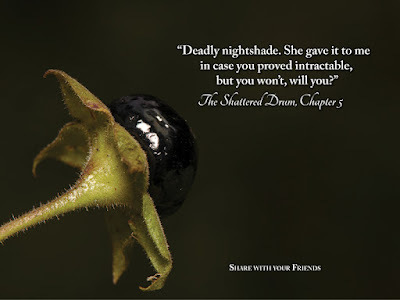

Note that these images all have a central image but lots of relatively free space where you can put text without either element overwhelming the other. Think about that as you are selecting between two equally good representations of your prose.
In closing, I offer the first teaser for my new novel, taken from chapter 1. Follow me on Facebook (cplesley.authorpage), Twitter (cplesley), Pinterest (cplesley), Goodreads (C.P. Lesley), Instagram (authorcplesley), and TikTok (authorcplesley) for new hints of what’s to come over the next month or so, as well as general updates on books I’m reading, interviews, and life in general. And of course, buy the book! If you like historical fiction set in a place just a bit beyond the ordinary, with a bit of adventure and a dollop of sweet romance, I promise you will enjoy it.
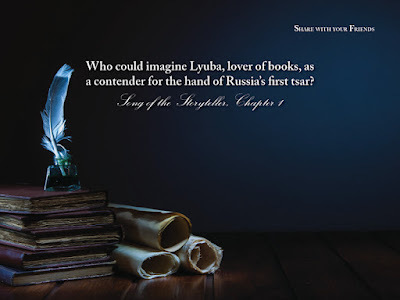
So if the idea of creating book teasers appeals to you, give it a try. They don’t always sell books, but in my experience, few “sure-fire” techniques exist. Promotion is like exercise: you have to focus on a few activities that you enjoy, or you’ll spend all your time making excuses and see no progress at all.
January 6, 2023
Bookshelf, Winter 2023
A new year, and a new book of my own (on which, more soon), but I still have a stack of other people’s new historical novels on my reading list, both via NetGalley and occasionally in print. As it happens, all of these are forthcoming between January and March of this year. So I’d better start reading fast!
 Lynn Cullen, The Woman with the Cure
Lynn Cullen, The Woman with the Cure (Berkley, 2023)
It seems safe to say that we have all heard of Joseph Salk and Albert Sabin, who developed the injected and oral polio vaccines. But how many of us know that the crucial identification of how polio spread in the body and where its trajectory could be interrupted came from a woman, Dr. Dorothy Horstmann? Because of her work and the contributions of her colleagues, both male and female, what was once an incurable scourge is now on the brink of eradication. In the midst of COVID-19 and the vaccine hesitancy stoked largely for political reasons, this look back has a special poignancy. I’ll be interviewing the author for New Books in Historical Fiction in February.
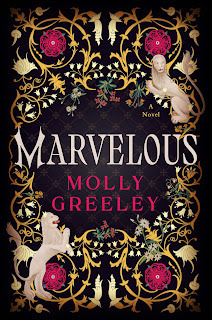 Molly Greeley,
Marvelous
(William Morrow, 2023)
Molly Greeley,
Marvelous
(William Morrow, 2023) Another unexpected window on a medical mystery, this novel by the author of two remarkable Jane Austen spinoffs tackles the real-life couple whose story became the basis of the fairy tale Beauty and the Beast. Petrus Gonsalvus, a captive from Tenerife in the Canary Islands, had a congenital condition that caused hair to grow all over his body. Brought to the Renaissance court of Henri II of France in 1547, he became the king’s ward and eventually married the beautiful sixteen-year-old daughter of a merchant fallen on hard times. Whatever she’s expecting from the arranged marriage, a guy who looks like Chewbacca is not it. Greeley’s writing is beautiful, and the tale of how this unlikely couple finds its way to acceptance and even love is heartwarming. We’ll be talking about it on the New Books Network in March.
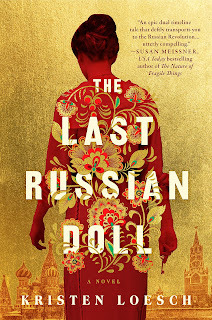 Kristen Loesch,
The Last Russian Doll
(Berkley, 2023)
Kristen Loesch,
The Last Russian Doll
(Berkley, 2023)This dual-time novel follows the quest of a young Oxford doctoral candidate named Rosie—who turns out to be Raisa, an escapee from Russia—to understand the circumstances that led to the murders of her father and older sister. In 1991, just as the USSR is dissolving, she agrees to work as an aide to a prominent dissident who is returning to St. Petersburg (then Leningrad).
Her story is contrasted with that of Antonina, a young merchant’s wife in St. Petersburg, who lives through the 1917 revolution and the Stalin period that follows. The relationships among these characters become clearer over time, symbolized by a set of porcelain dolls (not the expected wooden nesting dolls, which is a nice touch), each of which contains a clue to Rosie/Raisa’s past. I’ll be hosting a written Q&A with the author on this blog around the time of the book’s release in mid-March.

Joanna Lowell, Artfully Yours (Berkley, 2023)
I was under the impression, when I agreed to read this novel, that it was a historical mystery. Actually it’s not, but I’m so glad I misunderstood, because I might otherwise not have given the author the chance she so richly deserves. The book is a hoot, in the most delightful sense: a romance set in the late Victorian era that features a gifted painter and would-be baker earning her living as a forger of Old Masters and the one man in London with the art chops to reliably identify fakes. Add in a marmoset, a diva determined to wring a five-star review out of the art critic, a sisterhood of painters at war with the gallery administrators, and a dysfunctional family or three and you have all the ingredients for a delightful read. I hope to host a written Q&A with the author in late February and, with luck, I’ll have had the chance to read her two previous books before then.
 Erica Ruth Neubauer, Intrigue in Istanbul (Kensington, 2023)
Erica Ruth Neubauer, Intrigue in Istanbul (Kensington, 2023)This latest Jane Wunderley novel moves Jane and her beloved Redvers to the Bosphorus in search of her academic father, who has gone missing while on the hunt for the lost heart of Suleiman the Magnificent. It’s still 1926—meaning that Jane and Redvers have encountered no fewer than four mysteries in less than a year—and the personal quest is soon complicated with international intrigue and the arrival of Jane’s unstoppable Aunt Millie.
I really enjoyed the first three books in this series and look forward to discovering not just the answer to this mystery (for obvious reasons to do with my own interests, Suleiman the Magnificent is an immediate draw for me) but how the relationship between Jane and Redvers continues to develop. For more information about the series, listen to my New Books Network interview with the author last year.
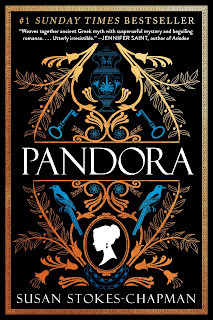
Susan Stokes-Chapman, Pandora
(Harper Perennial, 2023)
This fascinating retelling of the Pandora myth, with the box transformed into a Grecian urn, takes place in London at the very end of the eighteenth century. A young woman named Pandora and known as Dora lives unhappily with her grouchy uncle Hezekiah, who is doing his best to destroy the high-level antiques store left to him by Dora’s deceased parents. The discovery of the urn, so ancient it cannot be dated by the techniques available at the time, sets off a treasure hunt that forces Dora to confront the truth of her parents’ death, her uncle’s greed, her desire to achieve independence by selling her jewelry designs to eighteenth-century London’s equivalent of Tiffany’s, and the possibility of love—exemplified by the young man who aids her in her quest (for his own reasons, which soon become an impediment to his relationship with Dora). It’s a gripping read that starts slow but snowballs, and I’ll be talking with the author for New Books in Historical Fiction in January.

Sherry Thomas, A Tempest at Sea (Berkley, 2023)
Another series I loved, and for which I interviewed the author when book 6, Miss Moriarty, I Presume, came out. For reasons she explains in that interview, Thomas has reimagined Sherlock Holmes as his opposite: a plump, young blonde woman of aristocratic lineage who arranges for her own disgrace in book 1, A Study in Scarlet Women. I am so looking forward to reading this latest installment, and I was delighted when Thomas’s publicist pitched me with the NetGalley. I’ll be hosting a written Q&A with the author here on the blog after the book releases in mid-March.
And best wishes for a Happy New Year—and lots of great books—to all my readers and listeners!
December 30, 2022
And What a Year It's Been
 I’m not sure I’ve ever been so glad to see a year approach its ending as I am to say goodbye to 2022. The year began with a beloved elderly family member going missing (fortunately, he was found before anything bad happened to him) and slogged along from there. A massive project that clogged my work schedule and delayed everything that followed until the beginning of this month, a second crisis (which also ended better than it might have), and an apparently endless series of tasks associated with moving that elderly family member into assisted living left me so tense that three days after my annual Christmas break began, I was just starting to realize that I am on vacation and can get up late or do nothing if I like.
I’m not sure I’ve ever been so glad to see a year approach its ending as I am to say goodbye to 2022. The year began with a beloved elderly family member going missing (fortunately, he was found before anything bad happened to him) and slogged along from there. A massive project that clogged my work schedule and delayed everything that followed until the beginning of this month, a second crisis (which also ended better than it might have), and an apparently endless series of tasks associated with moving that elderly family member into assisted living left me so tense that three days after my annual Christmas break began, I was just starting to realize that I am on vacation and can get up late or do nothing if I like.Of course, even this year was not all disruption and chaos. I made the acquaintance of numerous lovely authors through written and podcast conversations; I received an unexpected payment from the New Books Network for ten years of interviews; I had some fascinating outside editing jobs; I acquired several new colleagues whom I enjoy working with; I got a clean bill of health on various issues that had cropped up since the pandemic began; I avoided getting Covid; and my husband and I adopted two gorgeous kittens who are a perfect joy—our older cat doesn’t agree, but that’s a subject for another post.

And last but not least, I finished another novel, the fifth in my Songs of Steppe & Forest series. Song of the Storyteller will be available in early January, as previously announced, and it was a huge amount of fun to write. I also made headway on the next book, and hope to get farther during this break. There are a couple of looming plot holes to fill and two sets of comments from my invaluable writers’ group to address (character inconsistencies, mostly). At the moment, both the story and its main protagonists feel very distant, but regular writing will fix that, and nothing else now stands in the way.
So that’s my year, in a nutshell. Let’s ring out the old, ring in the new, raise a glass of something bubbly, and hope for a less stressful 2023!
 Images: Stressed face, Happy New Year, purchased via subscription from clipart.com; kittens © 2022 C. P. Lesley
Images: Stressed face, Happy New Year, purchased via subscription from clipart.com; kittens © 2022 C. P. Lesley December 23, 2022
Interview with Darcie Wilde
 One of the interesting trends I’ve noticed in the last couple of years (although it’s been developing for much longer than that) has been a diversion of fiction set in Regency Britain from pure historical romance to mysteries, some of them quite gritty in their exploration of the slums and class differences that were as much a part of early nineteenth-century British society as the extravagant parties favored by the haut ton and the bucolic settings of Jane Austen’s novels.
One of the interesting trends I’ve noticed in the last couple of years (although it’s been developing for much longer than that) has been a diversion of fiction set in Regency Britain from pure historical romance to mysteries, some of them quite gritty in their exploration of the slums and class differences that were as much a part of early nineteenth-century British society as the extravagant parties favored by the haut ton and the bucolic settings of Jane Austen’s novels.Darcie Wilde’s Rosalind Thorne (now renamed A Useful Woman) series exemplifies this trend in its own particular way. Her heroine, as explained below, exists at the edges of aristocratic society, where she belongs by birth but not wealth. That gives her access to the drawing rooms of the rich and famous, but always as an outsider hired to perform a particular function. Ladylike to a fault, Rosalind combines a mastery of conventional behavior with an independent spirit and an observant eye. Read on to find out more, then seek out not just The Secret of the Lost Pearls —which releases on December 27, next Tuesday—but the earlier books in the series. Although you can read the books in any order, you will get the best appreciation for the various relationships and the fewest spoilers if you start at the beginning and go from there.
This is the sixth of your mysteries featuring Miss Rosalind Thorne. I’ve enjoyed all the ones I’ve read, and I tend to think of them as examples of what might have happened to Lizzie Bennet if she hadn’t married Darcy. How did you come up with this particular take on Regency society?
First of all, thank you for inviting me to your blog! My take on the Regency actually comes—and I should probably apologize for what I’m about to say, but—straight out of Austen. Jane Austen and her contemporaries were very much responsible for creating the modern novel. Like Austen, they dealt with women’s lives, with money, family, love, status, success, and failure. The lives, loves, and travels of all these women are fascinating as well, as were the various reasons they wrote. Some of them were world travelers, some of them were ladies at court, some of them were writing to save their families from ruin. These background stories are worthy of novels in and of themselves. So, in addition to the Great Jane, I’m drawing on this huge, rich mix of fact and fiction to create my Regency world.
Tell us a bit about Rosalind herself—her personality and what makes her the ideal heroine for your novels.
Rosalind is a member of London’s high society. She’s a bit above Lizzie Bennet on the ladder, but she’s in what gets called “distressed circumstances,” because her father abandoned his family. She’s got no money, so she’s got to make shift to make a living for herself, and she’s become a kind of personal assistant to society ladies. Only, while she was busy arranging a social calendar, she also wound up having to solve a murder.
Rosalind has had opportunities to follow the path expected of young society women during the Regency. What does it tell us about her that she ultimately embraces the moniker of “a useful woman” (and what does that mean)?
I found the concept of “the useful woman,” in a book written in 1826 by (deep breath), Lady Marianna Spencer Stanhope Hudson. It was titled Almack’s. In its day, this book was a huge, scandalous tell-all about a specific group of society women who ran London’s most famous and most exclusive ballroom. It was the place you wanted to go to see and be seen by potential marriage partners. Anyway, in the middle of this book, there’s one paragraph where one character is talking about another and saying “she’s really become such a useful woman.” It’s only a couple of lines. But the idea was that if a single woman had fallen on hard times, her better-off friends would start inviting her to their houses to stay, sometimes for months. In return, she’d do things for them like help with their correspondence, organize their social schedules, make calls for them, and generally make herself useful. In return, she’d get free room and board for the duration of her stay, she’d also get to use the carriage and be invited to all the parties, so she could still be a part of society, even if she couldn’t really afford it.
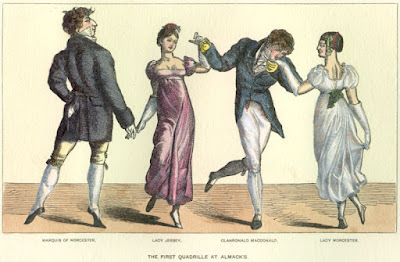
I had never heard of anything like this before, and I immediately said “This is the character I want to write about!” and that was when Rosalind came into being.
Now, Rosalind takes this concept three or four steps further. The problems she helps her ladies with are not only organizing social functions, but things like blackmail, and, of course, murder.
Adam Harkness assists Rosalind in the cases she chooses to take. How would you describe him and his role in the books? What makes him a good partner for Rosalind?
Adam is an officer at the Bow Street police station, so he’s got a lot of investigative experience of his own. But what makes him perfect for Rosalind is he understands and respects her. They also have complimentary freedoms. As a Bow Street “runner,” Adam doesn’t have access to the kind of aristocratic homes and lives Rosalind does, and that can be a real problem if he has to investigate a murder in high society. Rosalind, on the other hand, is limited in her movements simply because she’s a woman, whereas Adam has a lot of freedom, to, say, be out late at night on his own. So, the pair of them have plenty of ways they can each help each other out of (or into) trouble.
Please set up the mystery in this sixth novel. Who is Bethany Douglas, and why does she seek out Rosalind’s services?
Bethany is a distant acquaintance of Rosalind. Beth is happily married to a man from a rich family, but she’s also got a set of extremely problematic relatives; her mother’s a hypochondriac, her father drinks, one sister is relentlessly anti-social, the other ran away with a ne’er-do-well and is now back, claiming that the ne’er-do-well is dead. And as if that wasn’t enough, it now looks like the extremely valuable heirloom necklace her husband’s family gave her as a wedding present has been stolen, possibly by a member of her problematic family. She needs Rosalind to find out what happened to the pearls and get them back without creating any kind of scandal. And from there, things get a little complicated…
There is an implied tip of the hat here to Jane Austen’s Pride and Prejudice, which also supplies the epigraphs to most of the chapters—specifically to the relationship between Lydia and Wickham. What made you want to include that element?
I’d recently rewatched my favorite version of Pride and Prejudice (for the record, it’s the 1995 version with Jennifer Ehle and Colin Firth), and I got to thinking about Lydia and Wickham, and about the fact that it really must have been tough for the younger sisters in the Bennett family. They must have been so tired of always being compared to their entirely amazingly perfect older sisters. As I thought about it, I wondered what would have happened if instead of Lydia just being a silly little girl with no moral compass, Lydia was a schemer, and what if she went to Wickham and they together hatched the plan to run away and blackmail Darcy into paying to get Lydia married or returned home. Okay, in my version, she’d still have no moral compass, but she’d also have some guts, and some smarts.

The pearls mentioned in the title are a quite remarkable piece of jewelry. Describe them for us, please.
I love jewelry, so I had a lot of fun creating that necklace. In the Regency, it was pearls, not diamonds, that were considered the most precious gem. The necklace itself is three strings of pearls—two white and one black, with one large drop pearl in a gold and diamond setting as a pendant.
Will Rosalind and Adam continue their adventures? Where can we expect them to go next?
As a matter of fact, I’m just finishing their next book. This time the mystery hits closer to home than their other adventures have, and both Rosalind and Adam will find themselves having to make some very consequential decisions about what they want for their futures, and their relationship.
Thank you so much for answering my questions!
Thank you for inviting me!

Darcie Wilde is the author of five previous historical mysteries featuring Miss Rosalind Thorne and as many historical romances. Find out more about her at http://www.darciewilderomancecom.
Images: The First Quadrille at Almack’s and Portrait of Princess Dorothea Lieven, a patroness of Almack’s, wife of a prominent Russian diplomat, and acquaintance of Rosalind Thorne public domain via Wikimedia Commons; portrait of Darcie Wilde © Chris Amos.
December 16, 2022
Moving Forward
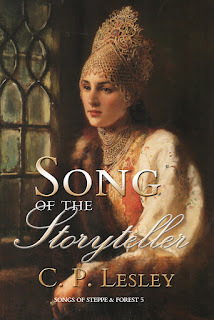 Just about two weeks from now, I will press the button that officially releases my latest Russian novel, Song of the Storyteller, into the world. The book has been ready for a month, but I learned the hard way that late November/early December is not a good time to publish something new. The demands of Christmas shopping slow everything to a crawl, and even purchasing author copies can take five times as long as normal. Not to mention that the general flood of new releases tends to overwhelm those of us who don’t have the luxury of a big publisher with a fully staffed publicity department at our backs.
Just about two weeks from now, I will press the button that officially releases my latest Russian novel, Song of the Storyteller, into the world. The book has been ready for a month, but I learned the hard way that late November/early December is not a good time to publish something new. The demands of Christmas shopping slow everything to a crawl, and even purchasing author copies can take five times as long as normal. Not to mention that the general flood of new releases tends to overwhelm those of us who don’t have the luxury of a big publisher with a fully staffed publicity department at our backs.No, January—when people have recovered from the holiday madness, perhaps received e-devices of some kind as presents, and (at least in my part of the world) are looking at months of chilly days and long, dark evenings—is a much better time to launch a new book. So this post is a prequel of things to come, not an actual announcement.
Some books are fun to write: they flow like mountain water from the fingers onto the screen; their characters cooperate with interesting takes on things and problems that anyone can relate to, naturally sharing their views with the author because that’s who they are. Other novels have to be hauled, howling and protesting (or, more often, squirreling their secrets away like so many October hazelnuts), into the light.
I’ve had a couple of the latter in this series, as well as some of the former. Juliana (Song of the Siren) was desperate to tell her story; I could barely keep up with the flood of information she poured into my head from morning to night. Grusha (Song of the Shaman) and Darya (Song of the Sisters) were the shy sort; for different reasons, it took me a long time to find the strength at the center of each of them and coax it out to a place where I could see it. Solomonida (Song of the Sinner) had a strong character from the beginning, as well as an interesting problem, but complicating her situation enough to create a compelling story took a lot of work.
Then came Lyuba: Lyuba the storyteller, the natural, the heroine I’ve always dreamed of writing. Self-aware even at sixteen, with a fiery temperament offset by her sharp observation of others and of social convention, Lyuba is determined to wrest what she wants from life in the same way as she plots her fairy tales and takes mental notes for the family saga that we know from The Shattered Drum she will one day write. And the situation she faces is both historically real (except for her part in it, of course) and tailor-made for fiction.

In December 1546, Grand Prince Ivan of Russia (soon to be known as Tsar Ivan the Terrible) decided to marry. He too was sixteen, and for various reasons it was decided that he would select a bride from among his own aristocracy rather than make a diplomatic marriage with a foreign princess. A call went out to all the principalities under Moscow’s control, demanding the nobles present their daughters to the government servitors sent to the provincial towns to make the initial selection. Those girls (we don’t know how many), as well as others representing the great Moscow families, were investigated and gradually winnowed to a small group, from whom Ivan selected a bride. Anyone who has read any of my previous Russian novels can guess that Lyuba’s father would leap at this opportunity like a man-sized salmon.
The summoning of potential brides in itself was not uncommon. Ivan’s father had held such a bride show twice, and later tsars continued the practice until Peter the Great abolished it in the eighteenth century as too medieval and Russian. But what makes it perfect for fiction is that the families who got their girls into the contest took it with deadly seriousness—and I do mean deadly. Candidates were poisoned, girls suddenly developed mysterious ailments that lasted just long enough for them to be given the boot, skeletons were dragged out of closets and shoved back into them. Lyuba and her best friend, Anna, are right to wonder if they will make it out of the Kremlin alive.
And they don’t want any part of the contest. Each of them is in love with a young man she cannot have, and neither has any interest in becoming Russia’s first tsaritsa. And if that seems strange, in a world where so many young girls dream of becoming princesses, well, really, would you want to be the wife of Ivan the Terrible?
I should note that while I was working on the final revisions for this novel, Russia launched its unprovoked invasion of Ukraine. As I write this post, that war continues, and for those of us who have spent our adult lives studying the long and complex history of that region, it feels as if the world has shifted on its axis. Given Russia’s current status as an international pariah, even to write sympathetically about the country’s past in a novel is a source of confusion and doubt. The tragedy of lives lost, infrastructure destroyed, childhoods fractured, injuries inflicted, cold and hunger endured makes Lyuba’s struggles trivial.
But I also know that many Russians are equally horrified by the actions of their government—indeed, many Russians have Ukrainian family members. And that is why I nonetheless hope that my fiction can, if nothing else, reveal some of the political assumptions, historical realities, and beliefs about Russia’s place in the world that continue, even five centuries later, to influence its actions.
Among other things, those actions are based on the lie that Ukraine is, and always has been, a part of Russia. The same justification was given for the annexation of Crimea. But my novels take place at a time when neither Crimea nor Ukraine was considered part of Muscovy. Perhaps that is one contribution they can make to the discussion.
You can find out more about Lyuba’s story at https://www.fivedirectionspress.com/song-of-the-storyteller. Meanwhile, I will be returning my fictional focus to Anna, the center of the next novel and, alas, another of those heroines who requires a gentle touch and lots of patience if she’s to find her way into the light.
Image: Grigory Sedov, Tsar Alexei Choosing a Bride (1882), public domain via Wikimedia Commons.
December 9, 2022
Money, Beauty, and the Power of Music
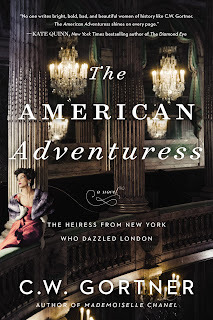 I had heard of C. W. Gortner as a writer of Tudor-era historical fiction long before I actually had the opportunity to read one of his books. That one,
The Romanov Empress
, had nothing to do with the Tudors (Gortner, who has a Master’s in Renaissance history, had long since moved on from the sixteenth century) and everything to do with my other great academic love: the history of Russia and the Soviet Union more generally. But by the time I read it, I had already agreed to let Jennifer Eremeeva have the fun of interviewing Gortner for the New Books Network.
I had heard of C. W. Gortner as a writer of Tudor-era historical fiction long before I actually had the opportunity to read one of his books. That one,
The Romanov Empress
, had nothing to do with the Tudors (Gortner, who has a Master’s in Renaissance history, had long since moved on from the sixteenth century) and everything to do with my other great academic love: the history of Russia and the Soviet Union more generally. But by the time I read it, I had already agreed to let Jennifer Eremeeva have the fun of interviewing Gortner for the New Books Network.Fast-forward a couple of years, and I received a pitch for his next book, The First Actress , about Sarah Bernhardt. The novel—more or less contemporaneous with The Romanov Empress, which focuses on Marie Fyodorovna, the Danish princess who became the mother of Nicholas II—arrived at another moment when I had no space in my interviewing schedule, but we set up a written Q&A for this blog. So when I received a message from this year’s publicist about the release of Gortner’s The American Adventuress —featuring Jennie Jerome, the mother of Winston Churchill—I was determined to move heaven and earth, if need be, to talk to Gortner for New Books in Historical Fiction. That interview went live yesterday. It was a fun conversation, very revealing about Jennie and her world, and the novel is already in print, so give it a listen and then read the book. It’s the perfect time of year, after all, to dive into an enchanting saga about glittering society parties, royal liaisons, and aristocratic scandals that can show up even The Crown.

The rest of this post comes from New Books in Historical Fiction.
From Lucrezia Borgia to Marlene Dietrich, Empress Marie Fyodorovna of Russia, and most recently the actress Sarah Bernhardt, C. W. Gortner has made a career out of finding strong, fascinating, real-life heroines for his novels. In The American Adventuress, he focuses his attention on Jennie Jerome, the mother of Winston Churchill.
From the moment we first meet her as a sassy and defiant twelve-year-old schoolgirl, Jennie charts her own course—to the consternation of her more conventional but in some ways wiser mother. Her father—an entrepreneur hovering on the edge of elite New York society—adores and supports this second daughter whose character so resembles his own, but some shady business dealings and a long-term affair with Jennie’s piano teacher eventually undermine his marriage. Jennie’s mother flees with her three daughters to Paris, where the girls complete their education. Then the Franco-Prussian War begins, and the family moves to London and safety.

There Jennie makes the acquaintance of an odd-looking but charming and intelligent young man, Lord Randolph Churchill, who proposes marriage almost right away. Jennie falls madly in love, and soon they are courting in earnest despite opposition from both their families.
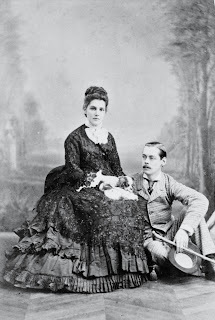 A gifted pianist, a beauty, a free spirit, and a loving if often-distant mother, Jennie lives life to the hilt: spending extravagantly, flirting outrageously, neglecting her children, and breaking convention in ways that defy our views of the constraints placed on Victorian women. But whatever her faults, Jennie herself is unforgettable, and it is Gortner’s achievement that he brings her so vividly to life.
A gifted pianist, a beauty, a free spirit, and a loving if often-distant mother, Jennie lives life to the hilt: spending extravagantly, flirting outrageously, neglecting her children, and breaking convention in ways that defy our views of the constraints placed on Victorian women. But whatever her faults, Jennie herself is unforgettable, and it is Gortner’s achievement that he brings her so vividly to life.Images: Jennie Jerome in 1880, with her two sisters, and with Lord Randolph Churchill in 1874—all public domain via Wikimedia Commons.
December 2, 2022
Interview with Rosemary Simpson
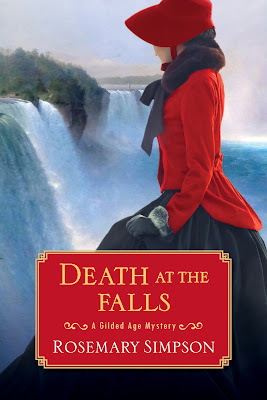 I’m sure I’ve mentioned before that I love finding a new series, especially one that explores elements of history less well known to me. Rosemary Simpson’s Gilded Age Mysteries came to my attention with book 7, set at Niagara Falls at a time when it was threatened by industrialization and the accompanying pollution.
I’m sure I’ve mentioned before that I love finding a new series, especially one that explores elements of history less well known to me. Rosemary Simpson’s Gilded Age Mysteries came to my attention with book 7, set at Niagara Falls at a time when it was threatened by industrialization and the accompanying pollution.Having read the latest installment, I was sufficiently intrigued to go back to the beginning to learn more about society heiress Prudence MacKenzie and her ex-Pinkerton investigative partner, Geoffrey Hunter. It’s a lovely series, well worth your time. Read on to find out what their creator has to say.
Death at the Falls is the seventh of your Gilded Age Mysteries. What attracts you to late nineteenth-century New York high society, broadly defined?
The late 1880s and early 1890s are a time that very much resembles our own age. Women’s issues are coming to the fore, and the wealth disparity between the very rich and the very poor has created enclaves of luxury and power alongside tenements of unrelieved poverty and disease. New inventions are becoming a part of everyday life: the telephone, electricity, elevators, experiments with horseless carriages. Railroads crisscross the country, making transportation rapid, affordable, and safe. Corrupt political machines dominate city, state, and national governments. High finance is controlled by a very few unscrupulous men who dominate the banking houses and stock exchanges. Advances are being made in medicine, but the poor are victims of diseases such as diphtheria, whooping cough, tuberculosis, typhus, and scarlet fever.
Seemingly oblivious to the harsh realities of most working lives, New York society in the Gilded Age whirls through rigidly exclusive rounds of balls, debutante presentations, nights at the opera, dinners at restaurants such as Delmonico’s. Women spend their days making social calls and being fitted for gowns that typically cost more than a laborer can earn in a lifetime. Men lose themselves in business, clubs, cigars, and mistresses.
Prudence MacKenzie and Geoffrey Hunter allow me to write about both worlds, about high society and the criminal underbelly of New York City. I’m also fascinated by what I learn as I take my characters out of their comfortable milieus and into places and situations most individuals of their wealth and social backgrounds would never dream of going.

Prudence MacKenzie is one of your two main characters. When we first meet her in What the Dead Leave Behind, she’s not in a good place, as we would say today. Describe her situation at that point in time.
Prudence’s father, a famous and well-respected judge in New York City, has died recently, leaving his daughter all of his considerable wealth. She is engaged to be married to a man she’s known since childhood. It’s not exactly a love match, but she trusts and admires him. The book opens in March 1888, during the night of possibly the worst snowstorm ever to have blanketed the east coast. Prudence’s fiancé is one of its victims—or was he murdered? Laudanum administered by a greedy and unscrupulous stepmother nearly robs Prudence of her fortune and her freedom. Only when she meets and engages the services of an ex-Pinkerton Southerner does it look like she’s found someone who can help her fight the laudanum addiction, foil the plots of her avaricious stepmother, and forge a new life for herself outside the confines of Gilded Age society.
How has she grown or changed as the series progresses?
Prudence’s decision to become an inquiry agent in the firm of Hunter and MacKenzie, Investigative Law, is an enormously daring step for a young woman of her age and social rank. She has to learn the detective skills that her partner mastered during his career in the Pinkertons and fend for herself in some of the seediest and most dangerous neighborhoods of the city while maintaining the social contacts that allow her to solve crimes that society would rather cover up. She becomes more self-confident with every case and more attracted to dangerous situations that a seasoned detective would avoid. She’s also falling in love with her partner, although she tries her best to deny it. Marriage means subservience during the Gilded Age, and she’s just taking her first steps toward independence.
What can you tell us about Geoffrey Hunter, your hero?
Geoffrey Hunter comes from a wealthy North Carolina plantation family that owned thousands of acres of land and hundreds of slaves before the Civil War. Too young to have fought in the war, he was sent north to an exclusive boys’ school where his Yankee education clashed with his father’s politics. Geoffrey left the South and his family to join the Pinkerton National Detective Agency, settling in New York City when he became disillusioned with some of the agency’s clientele and anti-labor tactics. He lives in a luxurious apartment at the Fifth Avenue Hotel, one of the city’s most prestigious establishments. Like Prudence, he’s independently wealthy but bored by the society life he’s expected to live. He’s in love with Prudence, but stepping cautiously, knowing that to move too quickly might seem threatening to a young woman tasting newfound freedom from male dominance.

What takes Prudence and Geoffrey to Niagara Falls? What do they find once they get there?
Prudence and Geoffrey are asked by Prudence’s English aunt to help a friend of hers with a legal case whose details Lady Rotherton deliberately leaves vague. Prudence, who has just passed the bar—only the second woman to be admitted to the practice of law in New York State—is eager to test her legal skills. What they find is a complicated family drama in which a grandmother denies the legitimacy of her son’s daughter in order to retain control of the family fortune. As the deaths mount up, the case becomes more complex. Old jealousies mingle with corruption, greed, and the fortunes to be made as Niagara changes from a sleepy little tourist town to a mecca for development.
The Niagara they encounter is, to put it politely, in transition to the place we know today. How would you describe it in 1890?
Niagara in 1890 is on the cusp of massive development in hydroelectricity as well as tourism. It had been a favorite vacation spot for many years, but until legislation created the Niagara Reservation in 1885 on the American side and the Niagara Parks Commission on the Canadian side, the three spectacular waterfalls and the surrounding land were exploited by private speculators who had little or no regard for the preservation of the area’s natural beauty. Contemporary pictures show factories spewing debris and wastewater over the cliffs and into the Niagara River. Everything costs money, even peering through a knothole in the wooden fences erected to block the view. Things improved for tourists once Frederick Law Olmsted’s design for a free public park became reality, but the power of the falls remained a magnet for the new and fiercely competitive electric power companies.

And last but not least, who is Crazy Louie?
Crazy Louie is an entirely fictional character who dreams of being the first person to go over Niagara Falls in a barrel and live to tell about it. The stunt, if successful, would make him world famous. He’s been experimenting with different woods, various barrel shapes, and animal passengers for years now. Louie is an oddball character of whom Niagarans are rather fond, but nobody knows where he gets the money for his experiments.
What are you working on now?
I’ve just completed Death Wears a Hidden Face, Gilded Age Mystery #8, to be published by Kensington in November 2023. Prudence and Geoffrey must solve a murder that takes them into Chinatown, where they encounter a culture neither has experienced before. The historical base of the book is the effect that the prejudicial Chinese Exclusion Act of 1882 had on the population of Chinese laborers who had been recruited to work in the California gold fields and build the transcontinental railroad. I’ve started the research for Gilded Age Mystery #9, which takes place in the New York City world of vaudeville and legitimate theater. No title yet!
Thank you so much for answering my questions!

Rosemary Simpson is the author of the Gilded Age Mysteries and two stand-alone historical novels, The Seven Hills of Paradise and Dreams and Shadows. Find out more about her at https://RosemarySimpsonBooks.com.
Images: “The Protectors of Our Industry," Puck cartoon showing various robber barons riding on the backs of workers; hand-colored lithograph of the Niagara suspension bridge (1856), crossed repeatedly by Prudence and Geoffrey in their attempt to solve this case; and Horseshoe Falls, Canada (1869)—all public domain via Wikimedia Commons. Photograph of Rosemary Simpson © Richard H. Simpson.
November 25, 2022
Gunpowder, Treason, and Plot
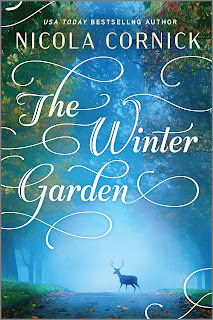 Although I write about the sixteenth century myself, I’m glad to see the publishing world’s obsession with Tudor England stretching to include the years that followed the death of Elizabeth I. Nicola Cornick’s latest novel,
The Winter Garden
, begins in the last decade of Elizabeth’s reign but centers around the 1605 plot to assassinate King James I, the formerly Catholic James VI of Scotland who converted to Protestantism to take the English crown and unite his country with its southern neighbor. Catholics, who had been much discriminated against under the Tudors—despite Elizabeth’s reputation for religious tolerance, as Cornick notes in our New Books Network interview —hoped for better treatment under James only to suffer disappointment. The Gunpowder Plot was their revenge.
Although I write about the sixteenth century myself, I’m glad to see the publishing world’s obsession with Tudor England stretching to include the years that followed the death of Elizabeth I. Nicola Cornick’s latest novel,
The Winter Garden
, begins in the last decade of Elizabeth’s reign but centers around the 1605 plot to assassinate King James I, the formerly Catholic James VI of Scotland who converted to Protestantism to take the English crown and unite his country with its southern neighbor. Catholics, who had been much discriminated against under the Tudors—despite Elizabeth’s reputation for religious tolerance, as Cornick notes in our New Books Network interview —hoped for better treatment under James only to suffer disappointment. The Gunpowder Plot was their revenge.But the personalities involved were far more complex and fascinating than the clichés passed down about them, as personalities always are. Cornick brings them vividly to life, exploring an unsolved mystery of who betrayed the plotters at the last minute and contrasting their lives with her modern heroine, Lucy Brown, who becomes caught up in their problems even as she struggles to find a solution to her own. Read on to find out more.
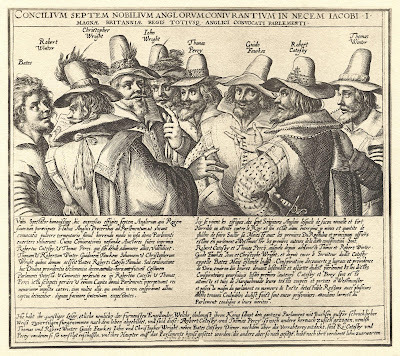
As ever, the rest of this post comes from New Books in Historical Fiction.
In her novels, Nicola Cornick blends a modern perspective with a historical mystery and a paranormal connection between the two. The Winter Garden revolves around the infamous Gunpowder Plot of 1605, known to every British schoolchild as the origin of Guy Fawkes Day, celebrated on November 5 with fireworks, bonfires, and bobbing for apples, among other things.
In the contemporary portion of the novel, Lucy, an internationally renowned concert violinist, has suffered a health crisis that strips her of her ability to perform. Facing the death of her career, she takes the opportunity to recover at a rural English estate. There she experiences bizarre dreams in which she appears to inhabit the body of a Tudor-era woman named Catherine, even as she is increasingly pulled into a relationship with Finn, an archeologist working on the gardens of the estate.

Alongside this modern story, we follow the events leading up to the Gunpowder Plot, told by Anne Catesby, the mother of the main conspirator. At first, past and present seem far apart, but as the novel progresses, the links between them become clearer and stronger. Anne and Lucy are both strong, determined women fighting circumstances beyond their control—for very different reasons—and they hold our attention to equal degree as they variously navigate the origins of the Gunpowder Plot, the fate of the Knights Hospitaller, and the discovery of a long-hidden treasure in a Tudor garden.
Images: Contemporary engraving of eight of the Gunpowder Plot conspirators, including Robert Catesby and the anonymous letter that reported them to the authorities public domain via Wikimedia Commons.



